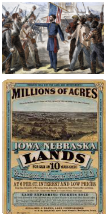U.S. History 1865 to the Present This course begins with an examination of the political, social, and economic challenges facing the nation reunited after civil war. Students learn fundamental concepts in civics, economics, and geography in the context of a chronological study of United States history. Students also explore the influence of individuals and groups and how their perspectives and actions affect historical events in the 20th and 21st centuries.
Essential Questions:
- What does hope look like in American history?
- What aspirations do we have as an American society — past, present, and future?
- How has America changed over time?
| Quarter |
Quarter 1 |
Quarters 1 & 2 |
Quarter 2 |
Quarters 2 & 3 |
Quarters 3 & 4 |
Quarter 4 |
|
Unit Title and Time |
Life After the Civil War: Units 1 & 2 (4 weeks) |
The Shine and the Shadows of the Industrial Age in America Units 3, & 4 (8 weeks) |
The United States on a Global Stage in the Early 20th Century Units 5 & 6 (6 weeks) |
The Ups and Downs of the 20s, 30s, and 40s Units 7 & 8 (7 weeks) |
Fighting for the Democratic Ideal in the World and at Home Units 9, 10 & 11 (9 weeks) |
Chasing Innovations and the Pursuit of Status Unit 12 (2 weeks) |
|
Image Cue |
 |

|

|

|

|

|
|
Focus of the Story |
We begin by examining the extent to which opportunities changed for a variety of people after the Civil War. We wrestle with why the new rights of freed peoples didn’t result in more meaningful change. |
Next, we investigate the challenges and accomplishments of immigration, industrialization, and urbanization. We explore the drama associated with many reform movements during this time that led to considerable change. |
We shift our focus to conflict and alliances with other nations. We examine foreign policy to better understand our motivations in growing our influence in the world. |
We return our attention to what’s happening at home as we analyze the cultural and economic impacts on daily life during the 1920s and 30s. |
Next we examine our role in world conflicts as the champion of democracy. We reckon with the need to address democratic ideals at home, which leads to civil rights movements. |
Finally, we explore innovations both nationally and globally to examine American influence in the world. |
|
Transfer Goals It is important to note that each transfer goal is likely to be present in each unit. The emphasis, however, will be placed on the ones explicitly identified. |
THINK: Comprehend how (evidence-based) sources and perspectives can clarify and contradict key information to better understand core issues (across contexts) in the past and present. (Knowledgeable, Thinkers and Inquirers, Cross-Culturally Competent) ACT: Communicate effectively based on purpose, task, and audience using valid and reliable information with accurate and relevant details* (Problem Solvers and Value Creators, Knowledgeable) |
ENGAGE: Engage in respectful discourse to exchange and process diverse information, ideas, and points of view in order to inform one’s own perspective and explanation (Communicators and Collaborators; Personally and Socially Responsible) ACT: Communicate effectively based on purpose, task, and audience using valid and reliable information with accurate and relevant details* (Problem Solvers and Value Creators, Knowledgeable) |
QUESTION: Ask and pursue a line of questioning based on curiosity, prior knowledge, personal experience, and ongoing research to establish patterns, draw well-reasoned conclusions, or take actions. (Knowledgeable, Thinkers and Inquirers, Problem Solvers and Value Creators) ACT: Communicate effectively based on purpose, task, and audience using valid and reliable information with accurate and relevant details* (Problem Solvers and Value Creators, Knowledgeable) |
ENGAGE: Engage in respectful discourse to exchange and process diverse information, ideas, and points of view in order to inform one’s own perspective and explanation (Communicators and Collaborators; Personally and Socially Responsible) ACT: Communicate effectively based on purpose, task, and audience using valid and reliable information with accurate and relevant details* (Problem Solvers and Value Creators, Knowledgeable) |
QUESTION: Ask and pursue a line of questioning based on curiosity, prior knowledge, personal experience, and ongoing research to establish patterns, draw well-reasoned conclusions, or take actions. (Knowledgeable, Thinkers and Inquirers, Problem Solvers and Value Creators) ACT: Communicate effectively based on purpose, task, and audience using valid and reliable information with accurate and relevant details* (Problem Solvers and Value Creators, Knowledgeable) |
CONNECT: Demonstrate civic and social practices through interactions with others and self-reflection in service of an interdependent global community. (Personally and Socially Responsible, Resilient Learners) ACT: Communicate effectively based on purpose, task, and audience using valid and reliable information with accurate and relevant details* (Problem Solvers and Value Creators, Knowledgeable) |
|
Learning Targets |
|
|
|
|
|
|
